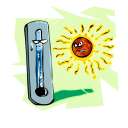
Worksheets and No Prep Teaching Resources
Reading Comprehension Worksheets
Weather

Weather
 Worksheets and No Prep Teaching Resources Reading Comprehension Worksheets Weather |
 Weather |
| edHelper's suggested reading level: | grades 7 to 8 | |
| Flesch-Kincaid grade level: | 6.79 |
|
Predicting the Weather
By Sharon Fabian |

|
 1 If the groundhog sees his shadow there will be six more weeks of winter. Watching the groundhog is one way of predicting the weather, but it's not the most scientific way. To really forecast the weather, you will need to look at things like wind speed, wind direction, temperature, air pressure, precipitation, and humidity.
1 If the groundhog sees his shadow there will be six more weeks of winter. Watching the groundhog is one way of predicting the weather, but it's not the most scientific way. To really forecast the weather, you will need to look at things like wind speed, wind direction, temperature, air pressure, precipitation, and humidity. |
Create Weekly Reading Books
Prepare for an entire week at once! |
| Leave your feedback on Predicting the Weather (use this link if you found an error in the story) |
 |
Weather
|
 |
Science
|